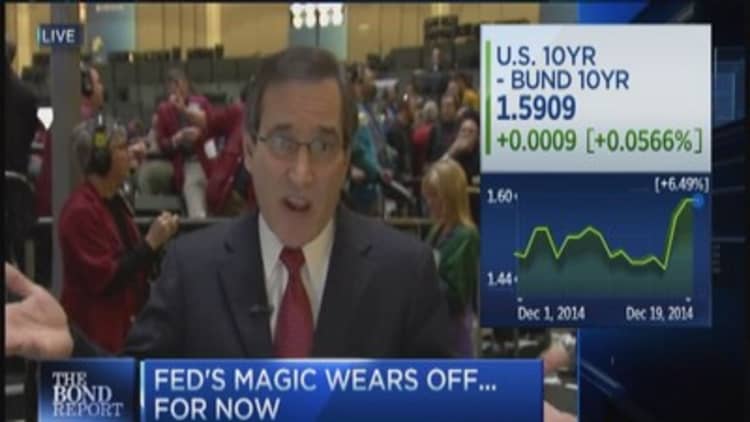The euro hit another nine-year low against the dollar on Wednesday, after data for the euro zone revealed that prices were falling in the region.
Prices in the euro zone fell 0.2 percent year-on-year in December, marking the first time since 2009 that prices have dipped into negative territory. This is likely to add yet more pressure on the European Central Bank (ECB) to launch a U.S. Federal-Reserve-style bond-buying program.
The common currency fell as far as $1.1840 following the news.

The dollar, meanwhile, trimmed some losses against the safe-haven yen amid a slight lull in the recent flight-to-quality bids. Tokyo's edged up after posting its biggest fall in 10 months the previous day and other Asian bourses also posted modest gains.
After slipping as low as 118.05 yen overnight, the dollar last traded at 119.12 yen, up 0.6 percent on the day.
Read MoreStocks could get drilled again by oil
Still, the dollar remained far from its 9-year peak of 121.86 hit last month as persistent weakness in oil prices and the prospect of deflation in Europe have continued to fuel investor demand for government bonds like U.S. Treasuries.
The recent fall in Treasury yields has given currency players an incentive to sell the dollar against the yen. The U.S. 10-year yield fell to a 12-week low of 1.887 percent overnight.
The Japanese 10-year yield has also dropped in the wake of the heightened risk aversion, reaching a new record low of 0.265 percent on Wednesday.
But this phenomenon, which should diminish the yen's attraction, has been overshadowed by the faster decline in Treasury yields. The U.S. 10-year yield has dropped by more than 20 basis points this month, while its Japanese counterpart has fallen 5 basis points.

"The yield curves of most sovereign debt markets are bull flattening so the fall in JGB yields has not attracted much attention," said Kyosuke Suzuki, director of forex at Societe Generale in Tokyo.
Markets are also looking out to the Federal Reserve's December meeting minutes due later in the session to gauge the central bank's stance on the timing of its first rate hike, which could occur later this year.
The divergence of monetary policies between the Fed and those of the ECB and the Bank of Japan provided a strong boost to the dollar last year.
"The Fed may not hike rates until June at the earliest. That is too far ahead for participants to make bets on, so meantime market focus rests on the ECB's (Jan 22) meeting and the BOJ, which continues to instil fear due to its unpredictability," Suzuki at Societe Generale said.
A standout performer was the , which rose broadly after international milk prices climbed again at a fortnightly auction, in part because of supply concerns.
The currency of the world's largest dairy exporting country rose to $0.7808, pulling well away from Monday's low of $0.7619. It has since trimmed its gains and was last $0.7751.
The kiwi also rallied against its Australian peer, which slid as far as NZ$1.0383 to an all-time low. The Aussie last traded at NZ$1.0404.
Traders suspect the kiwi will reach parity with its Australian peer before long.

